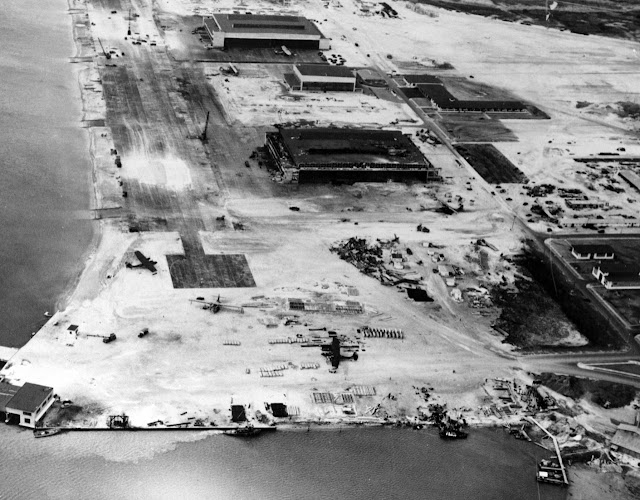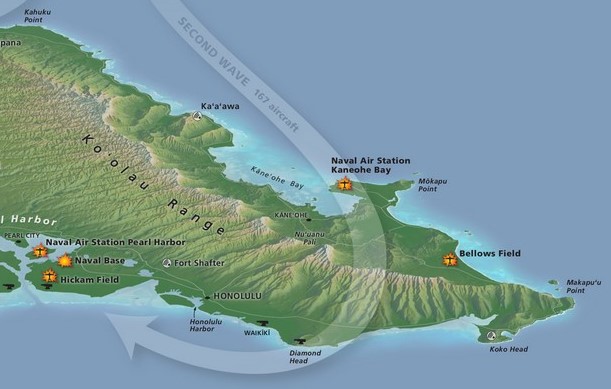Much of the nation first heard of the attack on a radio broadcast. It would have been quite a shock; to see the newspaper headlines would be another jolt. Dad heard about the attack from a friend, which could have been an only slightly more gentle way to get the news. I wonder what my father's initial reaction was. Did he have a sick, sinking feeling? Did he think about enlisting? Regardless, he had to know the attack would have a serious impact on his life at some point.
This is the first of three posts that will set the stage for my father’s 20-month tour of duty that began in September 1943 at Naval Air Station Kaneohe Bay, Oahu Island, Hawaii. The second post, The Philippine Islands – 8 Dec 1941-6 May 1942, is here, and the third post, Islands & Aircraft Carriers – May 1942-Aug 1943, can be found here.
* * *
Ford Island in Pearl Harbor with battleships moored
in Battleship Row on the left side of the island.
 |
|
Map of Oahu Island showing locations of the airfields
that were attacked. (National Park Service)
|
 |
|
The western portion of Oahu
Island is shown, noting airfields that were bombed, as well as locations of
radar sites. (National Park Service)
|
|
Pearl Harbor was
the primary target because there were U.S. aircraft carriers, battleships,
destroyers, and other ships harbored around Ford Island, as well as warplanes on the Ford Island and Hickam
airfields.
7:48 a.m. Wheeler Army Airfield is bombed.
Private Wilfred D. Burke described the attack on Wheeler Field: We watched a flight of planes pass to the west of Wheeler heading towards Pearl Harbor. Someone said that it was the Navy, but then we were surprised as black puffs of anti-aircraft fire filled the sky. Our surprise turned into terror when a Japanese aircraft from overhead began diving directly towards us. The diving planes released their bombs from one end of the hangar line to the other.
It was the first time I had ever seen a plunging dive bomber and it was an awesome sight. Nothing in warfare is more frightening. Hurtling down on us was the dive bomber being followed by another, while six or seven more in echelon awaited their turn. The leader pulled out right over us in a spectacular climbing bank. We could clearly see the rising sun of Japan on his wings and fuselage.
~ Pvt. Wilfred D. Burke, 72d Pursuit Squadron, Wheeler Field, 7 December 1941 (U.S. Air Force, p. 111, 113)
7:52 a.m. Naval Air Station Kaneohe Bay is bombed.
Only a few short minutes before Pearl
Harbor was attacked, a group of Japanese warplanes that had broken off the
first wave after bombing Wheeler Field reached Naval Air Station Kaneohe Bay.
The story would be the same as Pearl Harbor – everyone was taken by surprise
with chaos reigning as sailors tried to put out fires, move equipment, and stay
out of harm’s way. The second wave of Japanese planes hit the air station again
about thirty minutes later.
Sailors attempt
to save a burning PBY flying boat at Naval Air Station Kaneohe Bay, Oahu,
during the Japanese air
raid. The plane caught fire after being strafed in the initial phase of the attack and was sunk in a later strike. Note the dog observing the work. (Official U.S. Navy Photograph)
Aircraft wreckage and a badly damaged hangar at Naval Air Station Kaneohe Bay shortly after the Japanese air attack.
Note the disturbed
earth from the bombing in the foreground. (Official U.S. Navy Photograph) |
 |
| Battleship Row and Ford Island in Pearl Harbor in the foreground. Notice the disturbances on the surface of the water near the battleships. (National Archives) |
During the attack, the USS West Virginia (left) was severely damaged, the USS Tennessee (middle) was damaged, and the USS Arizona (right) was sunk. It sank in only nine minutes after a Japanese bomb pierced the forward deck, detonating over one million pounds of gunpowder in a powder magazine. The explosion created a huge fireball, killing 1,177 crewmen and officers. A sailor on the nearby USS Nevada saw the Arizona “jump at least 15 or 20 feet upward in the water and sort of break in two.” (Library of Congress)
8:54 a.m. The second wave of 167 Japanese aircraft - 35
fighters, 78 dive bombers, and 54 high-altitude
bombers - begin their attack. They are met with
heavy anti-aircraft fire.
9:30 a.m. A bomb blows off the bow of the destroyer USS Shaw.
Taken by an unknown navy photographer, this photo shows the USS Shaw exploding in Pearl Harbor. Pieces of the ship rained down a half-mile away. The stern of the USS Nevada can be seen in the foreground. (National Archives)
8 December 1941
A Declaration of War & Burials at NAS Kaneohe Bay
 |
|
A Marine rifle squad fires a volley
over the bodies of fifteen officers and men killed at Naval Air Station Kaneohe Bay during the Pearl Harbor raid. (Official U.S. Navy Photograph)
|
 |
| Naval Air Station Kaneohe Bay, Hawaii on December 9, 1941. (Naval History Heritage and Command) |
When the Oahu attacks were over
- 2,335 service personnel and 68 civilians were dead (1,177 were naval personnel on the USS Arizona),
- 1,143 people were wounded,
- 21 ships were sunk, damaged or run aground – including all eight battleships (six were repaired and returned to service, two were a total loss), and
- out of 402 aircraft in Hawaii, 188 aircraft were destroyed, and
159 were damaged (155 aircraft were on the ground at the time of the
attack). (Wikipedia, Pearl Harbor Facts)
Japan’s campaign to offset its lack of
resources began when it
- invaded Manchuria in 1931,
- attacked China in 1936,
- staged a successful takeover of French Indochina in 1940, and
- in the same year entered into an alliance with Nazi Germany and Fascist Italy.
The Japanese realized that to become an economically independent world power they would have to gain control of the Asian Pacific islands and parts of Asia where the natural resources they needed were available. And that meant going to war with the United States and Britain, since both powers had a considerable presence in those areas.
To that end, Japan devised an aggressive, well-coordinated, multi-stage plan of attack in the Pacific with the element of surprise at its core. The plan was designed to curtail a military response from the U.S. while Japan gobbled up the Asian Pacific islands and established its empire.
It began with the attack on Oahu Island and Pearl Harbor. Nine hours later Japanese warplanes launched attacks in the Philippines some 5,500 miles away.
NEXT: A Prelude to Service: The Philippines & Pacific Islands
* * *
~ Why warnings of the attack on Pearl Harbor were disregarded. This brief article about the first use of the new radar system on Oahu gives some insight into the multitude of errors made on December 7, 1941.
~ The Pacific War in Color is an excellent series by the Smithsonian Channel. It’s worth watching.
~ In February 1942, Japanese Americans were removed to internment camps around the United States. The last of them wouldn’t be released until March 1946; their stories are a heartbreaking part of American history. Among them was actor, George Takei, not quite five years old at the time. He went on to play Lieutenant Hikaru Sulu in the original Star Trek television series and subsequent movies. His mention and details about Japanese internment can be found here.














No comments:
Post a Comment